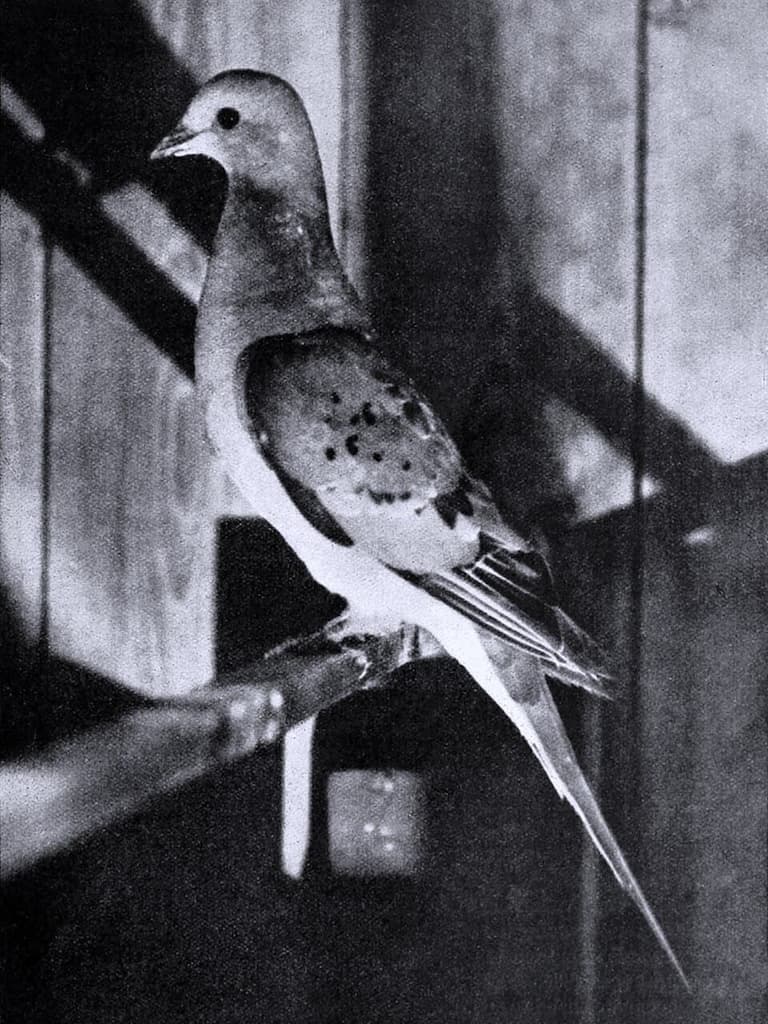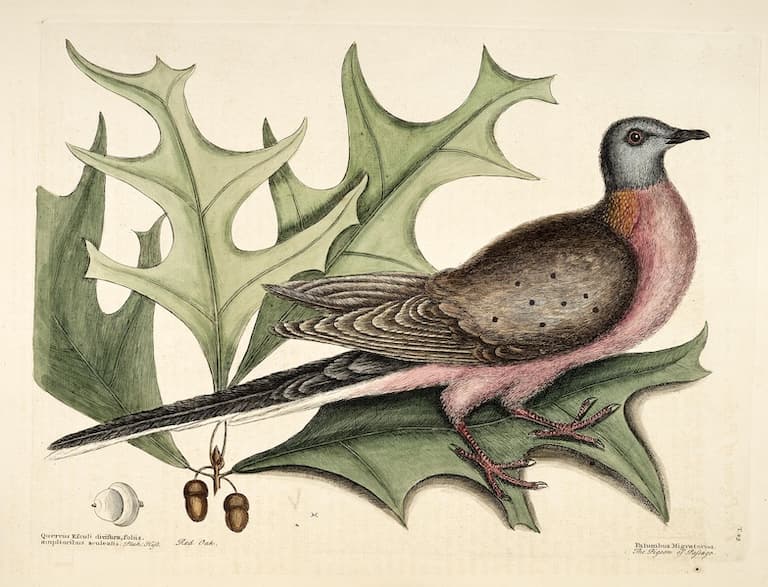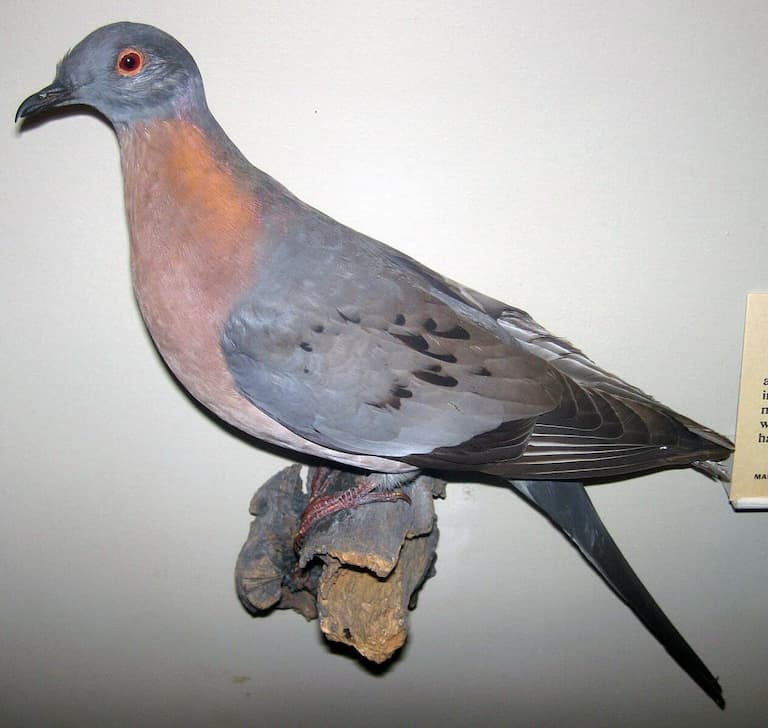Passenger Pigeon Profile
One of the most awe-striking massacres of any species occurred during a brief stint of European settlement in the US just a century ago.
One of the most populous vertebrate species on Earth was eradicated entirely, to the surprise of almost everyone, even today.
A celebrated naturalist of the time, Also Leopold, had this to say about the Pigeon, 47 years after its departure from the planet:
“Men still live who, in their youth, remember pigeons; trees still live who, in their youth, were shaken by a living wind. But a few decades hence only the oldest oaks will remember, and at long last only the hills will know.”
Yet, it remains a tragedy we are destined to repeat if we refuse to learn lessons from our past. 
Passenger Pigeon Facts Overview
| Habitat: | Deciduous forest |
| Location: | North America |
| Lifespan: | |
| Size: | 40cm (16 inches) long |
| Weight: | |
| Colour: | Grey, with black spots |
| Diet: | Forest fruits and nuts |
| Predators: | Humans |
| Top Speed: | 100 km/h (62 mph) |
| No. of Species: | 1 |
| Conservation Status: | Extinct |
As Europe ended a century of peace, the Passenger pigeon quietly slipped away. This bird once gathered in groups of hundreds of thousands. And reached populations that vastly exceeded that of our own at the time.
There were so many, that few assumed we could make a dent in them, and so they were hunted ruthlessly as an infinite resource, and by the time we realised the truth, it was too late.
With any luck, geneticists might bring them back, but this is a long shot and a desperate reactive measure to a problem that could have been solved a lot sooner, had it been taken seriously.
Interesting Passenger Pigeon Facts
1. There were once billions of them
It might seem intuitive, given that there are currently billions of humans, that animal populations would also reach into the eleven-figure range, but this should be more surprising – and shocking – to see populations this large in vertebrates (let’s not consider the twenty-quadrillion ants).
For example, in their heyday, before whaling decimated their populations, the ocean was teeming with whales. But estimates suggest that no species reached more than a few hundred thousand individuals.
And the great Wildebeest migration hosts a meagre 1.5 million of the iconic African bovids. The European starling, in flocks that used to block out the sun, is thought to comprise 200 million.
But these are rookie numbers compared with what was once North America’s most populous bird. The Passenger pigeon is said to have numbered well over three billion animals, and some estimates suggest up to five billion of these birds once flocked across the United States.

2. They were fast
Pigeons are notorious for their speed, as any bumpkin with a shotgun will confirm. The Passenger Pigeon did not disappoint in this regard, either. It’s said it could reach speeds of up to 100km/h, or roughly 62mph.
They’d hit these speeds during migratory flights, in which countless birds made the sky dark with their little bodies, often for days on end.
Nesting sites were found and established based on available resources, and they themselves were a sight to behold
3. Their roosting sites were bird cities
The Passenger Pigeon migrations would take them to the Southern states for Winter, and hardwood forests were preferred for their abundance of fruits and seeds.
Roosts would house a breathtaking number of birds, often enough to break the branches they were sitting on, and these would flock to the countryside for food each day.
Their chatter could be heard from miles away, and while no scientific record of their numbers has been recorded, one large roosting site was estimated to be home to around 136 million pigeons. 1 2
4. They were abundant until they weren’t
It’s hard to imagine a population this large could ever be threatened by the odd hunter, and this was exactly the justification for rejecting any attempt to protect the species.
In 1857, a protection bill was rejected, citing “…no ordinary destruction can lessen them”. But this proved to be false.
While Michigan passed some loose laws, enforcement was lacking, and by the time restrictions were ramped up it was too late.
Captive breeding programs were set up, but without their tens, or hundreds of thousands of friends, the captive pairs didn’t fare well.
Rewards were offered for their discovery, but by 1900, they were never found in the wild again.
5. Human population increases wiped them out
The native tribes commonly hunted passenger pigeons for subsistence, but the arrival of vast numbers of Europeans brought a huge increase in hunting and what began as a slow decline in numbers for the first half of the 1800s accelerated from 1870, until the last wild bird was shot in Ohio in 1900.
Hunting wasn’t the only threat to this species. The enormous nesting colonies of these birds were threatened by habitat destruction, as more and more forest was cleared for livestock farming and grazing.
Both the rail network and telegraph system facilitated the capture and transport of young birds to market, and these sudden technological advances proved too much for the species to recover from.
While there were some birds in captivity by the time they went extinct in the wild, fourteen years later, the last one, called Martha, died in Cincinnati Zoo. 3
6. This is not an isolated incident
At the time of the Passenger pigeon’s extinction in the wild, the population of humans was 1.6 billion. At the beginning of their decline, it was only one billion. In just over 200 years, or roughly ten generations, we have multiplied eight-fold and brought with us an increase in the environmental destruction that destroyed this pigeon species.
Extinctions are therefore ongoing, and at an increasing rate, and many of the species we grew up with may not be around for the next generation to admire.
The case of the passenger pigeon is a perfect example of reacting to a problem too late, and it should speak to us all as a lesson about what can and will happen if we assume the world’s resources are infinite, and simply nature too big to be affected by our humble presence.
This bemusement is even reflected in the scientific community. How could the most abundant species of bird in the world be wiped out simply by human presence? Researchers have looked to explain it through some kind of lack of genetic diversity on the pigeon’s part and come up short.
The simple fact is that we are a rapidly expanding, destructive force, and evolution cannot keep up.
Birds like the starling, once common in vast, hypnotic murmurations in our skies, are dwindling due to the same habitat destruction and disregard for wildlife that doomed the Passenger pigeon. But some think we might be able to reverse this process.

7. The Passenger Pigeon Project
Unlike some de-extinction projects that focus simply on selectively breeding a close relative to appear similar to their extinct counterpart, the Passenger Pigeon Project by Revive and Restore, takes a more holistic approach to bringing back the living wind to our forests.
They also plan to use gene editing – a much more precise, faster, and yet expensive method of genetically modifying an animal – to reactivate the Passenger pigeon genes from its close relative, the Band-tailed Pigeon.
This model is hoping to prove a pioneer for de-extinction methods, and the passenger pigeon a figurehead for forest restoration and conservation.
Yet, as this also demonstrates, there is no substitute for early protection, and had there been a proactive approach to passenger pigeon conservation, there would be no need for such drastic, expensive and uncertain attempts to bring it back. 4
Passenger Pigeon Fact-File Summary
Scientific Classification
| Kingdom: | Animalia |
| Phylum: | Chordata |
| Class: | Aves |
| Order: | Columbiformes |
| Family: | Columbidae |
| Genus: | Ectopistes |
| Species: | migratorius |
Fact Sources & References
- “The Passenger Pigeon”, Smithsonian.
- “Billions to none… the extinction of the Passenger Pigeon”, Audubon.
- “Ectopistes migratorius”, IUCN Red List.
- “PASSENGER PIGEON PROJECT”, revive & restore.
